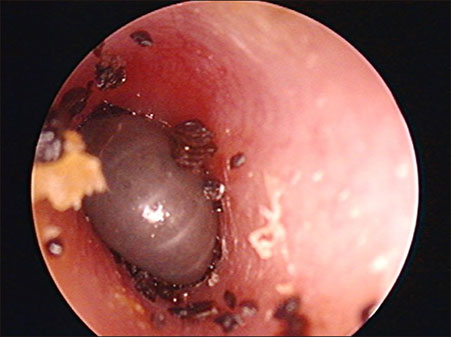Ann Dermatol.
2018 Jun;30(3):348-350. 10.5021/ad.2018.30.3.348.
An Uncommon Presentation of Human Otoacariasis by Haemaphysalis longicornis
- Affiliations
-
- 1Department of Dermatology, College of Medicine, The Catholic University of Korea, Seoul, Korea. jwkim52@catholic.ac.kr
- 2Department of Otolaryngology, College of Medicine, The Catholic University of Korea, Seoul, Korea.
- 3Department of Parasitology, Yonsei University College of Medicine, Seoul, Korea.
- KMID: 2419179
- DOI: http://doi.org/10.5021/ad.2018.30.3.348
Abstract
- Ticks are obligate parasites on animals and sometimes humans. They usually suck the blood of the hosts and can carry various infectious diseases as a vector. Otoacariasis is the presence of ticks and mites within the ear canal and relatively common in domestic and wild animals. However, tick infestations of human ear canals are rarely reported in the scientific literature and hardly occur in developed countries. Herein, we report a rare case of otoaracariasis involving Haemaphysalis longicornis . A 9-year-old girl living in a suburb presented with otalgia of left ear for 1 day. Otoscopic examination revealed a huge insect occluding the tympanic membrane. Tick removal and washing of external auditory canal was done successfully. The causative tick was identified as the H. longicornis. To our knowledge, this is the first reported case of human otoacariasis by a H. longicornis in Korea.
Keyword
MeSH Terms
Figure
Reference
-
1. Roh DK, Jang IG, Cho BK, Son SJ, Lee IY, Lee WK. Tick bite by haemaphysalis longicornis Neumann: laboratory observation of the causative tick. Korean J Dermatol. 1999; 37:631–636.2. Hoogstraal H, Roberts FH, Kohls GM, Tipton VJ. Review of Haemaphysalis (kaiseriana) Longicornis Neumann (resurrected) of Australia, New Zealand, New Caledonia, Fiji, Japan, Korea, and Northeastern China and USSR, and its parthenogenetic and bisexual populations (Ixodoidea, Ixodidae). J Parasitol. 1968; 54:1197–1213.
Article3. Dilrukshi PR, Yasawardene AD, Amerasinghe PH, Amerasinghe FP. Human otoacariasis: a retrospective study from an area of Sri Lanka. Trans R Soc Trop Med Hyg. 2004; 98:489–495.
Article4. Cakabay T, Gokdogan O, Kocyigit M. Human otoacariasis: Demographic and clinical outcomes in patients with ear-canal ticks and a review of literature. J Otol. 2016; 11:111–117.
Article5. Barker SC, Walker AR. Ticks of Australia. The species that infest domestic animals and humans. Zootaxa. 2014; (3816):1–144.6. Fegan D, Glennon J. Intra-aural ticks in Nepal. Lancet. 1996; 348:1313.
Article7. Iwasaki S, Takebayashi S, Watanabe T. Tick bites in the external auditory canal. Auris Nasus Larynx. 2007; 34:375–377.
Article8. Somayaji KS, Rajeshwari A. Human otoacariasis. Indian J Otolaryngol Head Neck Surg. 2007; 59:237–239.
Article9. Gökdoğan O, Çakabay T, Baran H, Karabulut B, Tasdemir C, Vatansever Z. Otoacariasis: demographic and clinical outcomes of patients with ticks in the ear canal. Braz J Otorhinolaryngol. 2016; 82:416–421.
Article10. Indudharan R, Dharap AS, Ho TM. Intra-aural tick causing facial palsy. Lancet. 1996; 348:613.
Article
- Full Text Links
- Actions
-
Cited
- CITED
-
- Close
- Share
- Similar articles
-
- Resistance and control of cypermethrin and chlorpyrifos as acaricide for control of hard tick Haemaphysalis longicornis (acari: ixodidae)
- Three Cases of Tick Bites by Haemaphysalis Longicornis
- Immunization effect of recombinant P27/30 protein expressed in Escherichia coli against the hard tick Haemaphysalis longicornis (Acari: Ixodidae) in rabbits
- Tick bite by Haemaphysalis longicornis Neumann: Laboratory Observation of the Causative Tick
- No Detection of Severe Fever with Thrombocytopenia Syndrome Virus from Ixodid Ticks Collected in Seoul



